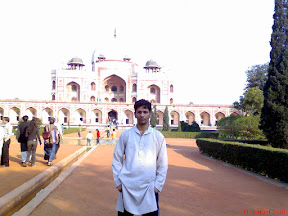A Visit to Humayun's Tomb
It was winter saturday and a sunny day. I decided to go out with family. Usually we hang out at some mall in Delhi but this time my wife suggested to visit some historical place. After a shoot discussion, we agreed on Humayun's Tomb. We also took children of my brother-in-law, who lives nearby, with us for the company of my daughter, Yanshi. I drove to the site comfortably as the traffic was smooth. There were little issue at the parking as the whole parking was full. But I managed to get place for my car at the VIP parking area.

Earlier we planned to sit there in the garden, but later decided against it. My daughter argued that this is not a park. Since we came to see a historic monument, we must explore it. So we left our snacks and coffee in the car.
We entered the entrance gate of the complex and welcomed by the well maintained garden. Thanks to ASI, which has the responsibility to maintain the heritage sites in Delhi and in India. After waling a few steps in the pathway between the garden, we encountered another gate. A guard was checking the tickets, so I learn that we must buy tickets. I purchased two tickets for me and my wife for Rs. 10 each. The entry for children below 15 year was free.
We entered the gate and found that people were going in two directions. Straight from the gate was the main entrance of the Humayun's tomb. At the left hand, there was another gate which leads to the Isa's tomb. We decided to see the Isa's tomb first. I will describe the Isa's tomb later in another post.
After we have seen the Isa's tomb and the mosque in its premises, we headed towards the Humayun's tomb. The main entrance of the tomb is guarded by a double story gate, made up of red and white sand stone. One thing that caught my eyes were two stars, one at each side of the of the gate. These stars are printed in white color on the pink sandstone. The look of the gate is almost same from both sides - outer and inner.
On reaching inside the gate, there were large garden, divided in four parts by swallow water channels. In front of the main entrance of the building, there was a small rectangular tank of water. Now they have installed a fountain in it.

The main building on the stage is made of the combination of red sandstone and white marble. White marble is used for decoration over the background of red sandstone.
Around the main dome, above the stage, were many graves. Something were written on these graves in Urdu, so I could not know whose graves were these. But I believe that these were the graves of other members of Humayun and Akbar, his son.

There were other graves in other cells as well.
Related Links

